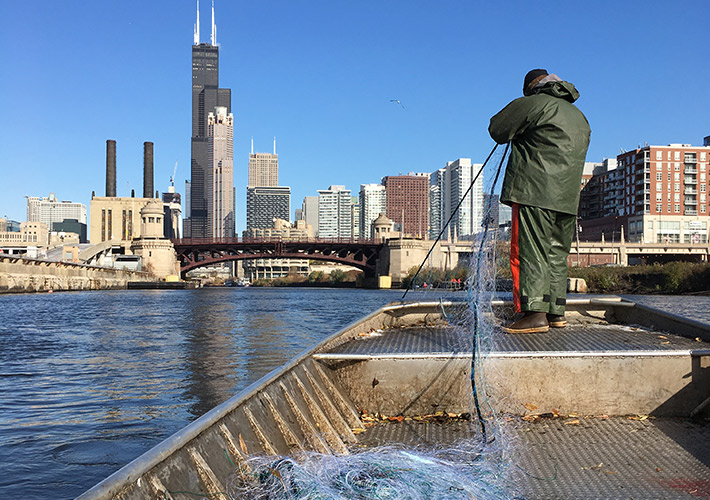UPDATE: No Asian carp found in follow up sampling, second week being delayed for worker safety
November 8, 2019
Contacts:
Katie Steiger-Meister
U.S. Fish and Wildlife Service
612-723-4839
katie_steiger-meister@fws.gov

Contracted fisherman aboard a boat participating in Bubbly Creek response actions in the South Branch of the Chicago River.
Photo courtesy of IL DNR.
Chicago – The Illinois Department of Natural Resources (IDNR) and partner agencies under the leadership of the Asian Carp Regional Coordinating Committee (ACRCC) have found no Asian carp in the first week of searching for the invasive fish in the Chicago Area Waterway System (CAWS).
Following the Oct. 30, 2019 notification of the presence of environmental DNA (eDNA) in Bubbly Creek, which is part of the CAWS, the agencies jointly decided to pursue an intensive survey of the area for live bighead and silver carp.
Response efforts included follow up eDNA sampling Oct. 30 by the U.S. Fish and Wildlife Service (USFWS), as well as intensive netting and electrofishing near Bubbly Creek and the surrounding 10 miles of river by IDNR, USFWS, and the U.S. Army Corps of Engineers.
Agency biologists surveyed more than 150 sites, completing 17 hours of electrofishing and setting 10 miles of nets in the first week of monitoring. Close to 600 fish were captured in these efforts, including 16 species. Largemouth bass, bluegill, and pumpkinseed, along with state threatened banded killifish, were some of the native fish seen along with non-native species such as common carp, goldfish, and a single tilapia.
Notably, netting and electrofishing revealed no live fish present within Bubbly Creek where positive eDNA was originally detected by USFWS. At this time, water quality in this area of Bubbly Creek was found to be unlikely to support live fish.
Live fish are only one possible source of eDNA. Other sources include wildlife that may feed upon Asian carp and travel into or through the area, as well as DNA that may be on boat hulls or water transported by vessels. Even dead bighead carp or sliver carp, such as ones found in local markets, may also provide genetic material (DNA) that could be detected.
The ACRCC believes that continued response is important due to the presence of the large amount of eDNA that was detected in the environment by the USFWS in October. However, the National Weather Service is calling for near record cold and below freezing weather in Chicago during the week of Nov. 11, leading to a dangerous working environment for responders, making boat decks icy and causing nets to freeze. Based upon results from the first week of response, response activities scheduled for Nov. 12-15 will be postponed until Nov. 18-22. This will allow for safe and thorough sampling of this portion of the waterway and will add an additional day of response that would have been omitted due to the Veterans Day holiday on Nov. 11.
IDNR and ACRCC representatives will provide updates on the entire response efforts upon the conclusion of the sampling Nov. 22 and any necessary assessments via www.asiancarp.us.
